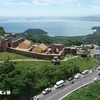Hanoi (VNA) – The Central Highlands province of Dak Nong has established its position in the national tourism map after the UNESCO granted the global status to its Dak Nong Geopark.
Dak Nong province is home to 40 ethnic minority groups and diverse natural resources. It has served as the gateway between Central Highlands provinces and the southern key economic zone and the south central coastal region.
However, the locality has been popular to domestic and foreign tourists only after its Dak Nong Geopark won the global title.
The Programme and External Relations Commission of the 209th UNESCO Executive Board on July 7 approved the Global Geoparks Council’s proposal to recognise Dak Nong Geopark as a Global Geopark, the third of its kind in the country.
Dak Nong Geopark covers an area of more than 4,700 km2, stretching over six of the eight districts of the province with 65 sites of natural heritage, geomorphology, including craters, volcanic caves and waterfalls, according to UNESCO.
Possessing one of the most significant volcanic cave systems in Southeast Asia, Dak Nong Geopark also includes the many unique cultural features of forty ethnic minority groups. This means that other than enjoying stunning landscapes, visitors can experience a wealth of cultural diversity and enjoy numerous ethnic minorities’ cuisine and festivals.
Optimising natural and cultural values
Dak Nong Geopark is distinctive in terms of geological features and geoheritage value. Being a piece of the Gondwana ancient supercontinent, from about 200-165 Ma ago it was deeply submerged into a passive continent marginal sea, very rich in ammonite and bivalve fossils.
This continental margin later, during 145-66 Ma ago became active due to plate collision, with red-bed sediments, eruptive andesite-dacite-rhyolite and intrusive gabbro-diorite-granodiorite-granite rocks. During the last 16.5 Ma, the territory became active again with wide-spread, multi-phase volcanic activities, forming a basalt covering more than 50 percent of the Geopark area.
These have been the source of some of the world’s largest and top quality bauxite deposits and a number of other minerals (sapphire, semi-precious stones etc.), and especially the fertile soils that have fed generations of local people with many industrial and fruit tree crops. In particular, young volcanic activities about tens of thousands of years ago (Late Pleistocene-Holocene) have resulted in spectacular craters, majestic waterfalls and Southeast Asia’s most extensive system of hundreds of magnificent volcanic caves, many of which have been used by prehistoric people as shelter since at least 6,000-10,000 years ago.
The UNESCO’s recognition has contributed to affirming Dak Nong’s global tourism values. Therefore, the locality aims to maximise values of geology and geomorphology, as well as traditional culture
Dak Nong has identified 44 destinations and three tours to Gia Nghia city and five districts, offering opportunities for visitors to explore unique values of the province.
Ton Thi Ngoc Hanh, Vice Chairwoman of the provincial People’s Committee, said Dak Nong’s tourism products are expected to contribute to promoting local tangible and intangible cultural heritage like UNESCO-recognised “Gong Culture Space”, folk songs and crafts, along with dishes of local ethnic minority groups.
Diversifying tourism products
According to provincial leaders, apart from tourism products associated with the tangible and intangible values, Dak Nong has focused on adventure, community-based and leisure tourism.
With the Ta Dung, Nam Cat Tien and Yok Don national parks, the Nam Nung national conservation area, the Dray Sap special-use forest and waterfalls, among others, Dak Nong has potential to develop adventure tourism.
Notably, community-based tourism would help Dak Nong reduce poverty, raise income of local residents and boost export.
Hanh said she hopes that with its potential and efforts, Dak Nong will soon become a bright tourist destination despite difficulties in infrastructure and human resources./.


























